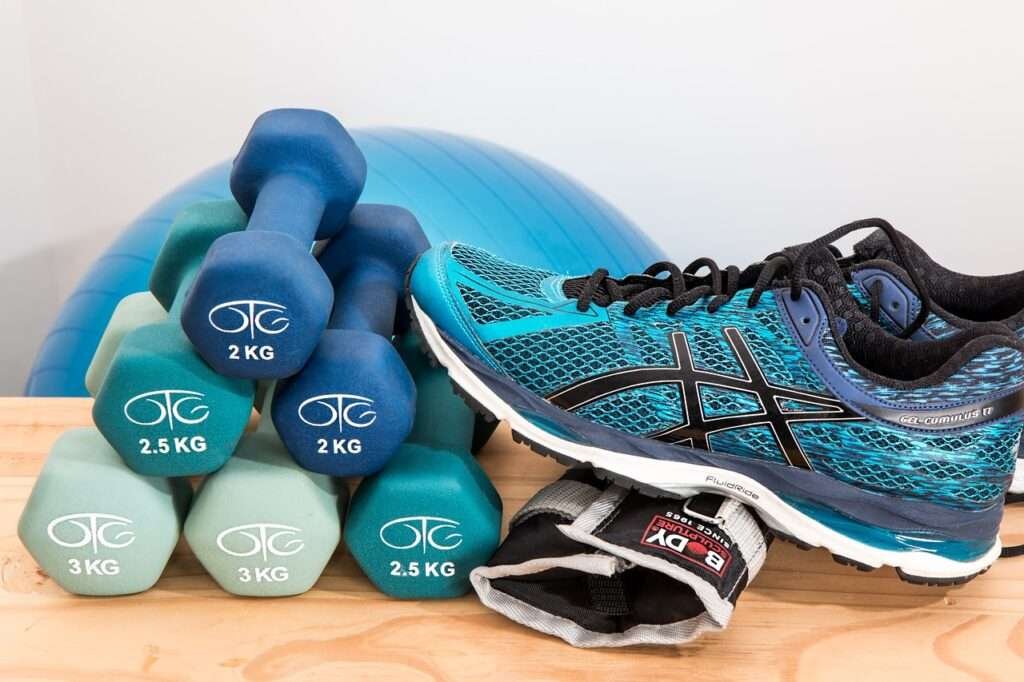We’ve all been there: you’ve planned to go to the gym, but when it’s time to get there, you don’t feel like going. Do thoughts like “I am too tired” and “I will go tomorrow instead” sound familiar to you?
The path to a healthier and more active lifestyle requires pushing through those moments when you don’t want to go to the gym and stick to your good habits. In this blog post, we explore how to get to the gym when you don’t want to. We offer practical strategies to help you overcome your reluctance and make exercise a consistent part of your routine.
Table of Contents
Set Clear Goals
The first step in overcoming your resistance to going to the gym when you don’t feel like it is to set clear and achievable goals. Having a purpose or target provides you with a stronger reason to get up and get going. In short, it gives you a strong ‘why’.
Whether it’s losing weight (use our BMI calculator to see whether your weight is healthy), building muscle, improving cardiovascular health, or simply feeling better about yourself, defining your goals creates a sense of purpose and motivation. So, write down your goals and keep them visible.
When you have a clear vision of what you want to achieve, it becomes easier to muster the motivation to go to the gym. And when you don’t feel like going, look at your goals and decide what’s more important to you. If your ‘ why’ is strong enough, it will win from laziness.
Create a Workout Plan
A well-structured workout plan is a game-changer when it comes to going to the gym when you don’t want to. Having a plan in place gives you a sense of direction and makes your gym sessions more efficient and productive.
I personally use my digital calendar to plan my gym sessions. They are automatically recurring events, so I don’t even have to put them in my calendar. Over time, going to the gym will become a habit that is hard to break.
Here’s how to create a workout plan that works for you:
- Define your fitness goals: Are you looking to build strength, increase endurance, or lose weight? Your goals will shape your workout plan, as your goals determine which kinds of exercises you’ll do.
- Choose exercises you enjoy: It’s essential to pick exercises that you find enjoyable (or at the very least don’t hate). This will make the gym more appealing, helping you overcome resistance when your motivation is low.
- Schedule your workouts: Consistency is key. Set specific days and times for your gym sessions and treat them as non-negotiable appointments with yourself. I can highly recommend making your gym sessions automatically recurring events, as this creates an opt-out situation instead of an opt-in. And if you struggle with consistency, check out the 2-Day Rule to become more consistent.
- Start with manageable intensity: If you’re just starting, don’t overwhelm yourself with intense workouts. Begin with a level of intensity that you’re comfortable with and gradually increase it as you become more accustomed to regular exercise. There is no shame in starting with easy exercises that you feel comfortable with.
Find an Accountability Partner
Accountability partners can be a significant source of motivation when you don’t feel like going to the gym. Having someone who shares your fitness goals and can hold you accountable for your gym attendance can make a huge difference.
It’s easier to hit the snooze button when you’re the only one affected. However, when you know someone is waiting for you at the gym or expecting you to check in on your progress, it becomes much more challenging to skip your workout. The shared commitment and support system can help you stay on track even when your motivation is waning. In that way, going to group fitness classes might be helpful to you.
I personally love to go to the gym with friends, and when we’ve all agreed to go on a specific date and time, it’s much harder to skip that session.

Change Your Perspective
Sometimes, the key to getting to the gym when you don’t want to is shifting your perspective on exercise. Instead of viewing it as a chore, try to see it as an opportunity to improve your physical and mental well-being. Exercise is a form of self-care, a break from the daily grind, and a way to boost your mood and energy levels.
By changing your mindset and focusing on the positive aspects of working out, you can make it more appealing, even when you’re not in the mood. One of the most important reasons why people skip their gym session is because they feel too tired. But did you know that going to the gym actually helps against tiredness? Being aware of this can help you go when you don’t feel like going.
Commit To A Short Workout
When you’re feeling particularly unmotivated, the prospect of a long and grueling workout can be a daunting one (I know that feeling all too well). In such situations, simply commit to a short workout. Tell yourself you’ll only spend 20-30 minutes at the gym. This approach reduces the perceived effort and can make the idea of going to the gym much more manageable.
Chances are, once you get started, you’ll find that you have more energy and motivation than you initially thought (this has happened to me every single time). This can lead to a longer and more productive workout, but the key is getting through the initial barrier of reluctance.
Pre-Workout Rituals
Establishing pre-workout rituals help you transition from a state of reluctance to enthusiasm. These rituals signal to your brain that it’s time to get ready for the gym and create a sense of anticipation and excitement. Some pre-workout rituals you could consider:
- Lay out your workout clothes the night before and benefit from the 20-Second Rule.
- Prepare a healthy snack or smoothie to consume before your workout.
- Listen to a motivational playlist that pumps you up.
- Spend a few minutes visualizing a successful and productive gym session.
Reward Yourself
Rewarding yourself for going to the gym, especially when you don’t want to, can be an effective motivator. Set up a reward system that gives you something to look forward to after each workout. It can be as simple as treating yourself to a favorite (healthy) snack, watching an episode of your favorite TV show, or enjoying a relaxing bath.
The anticipation of a reward can act as a powerful incentive to get to the gym. Over time, your brain will start associating exercise with positive experiences, making it easier to overcome the resistance.
When I get back home from the gym, I reward myself with a high protein chocolate mousse. It’s helpful because of the protein, it’s delicious and it gives me another reason to go to the gym, as I can only have this chocolate mousse after a gym session.

Set Up a Home Gym
If the idea of commuting to the gym is a significant barrier for you, consider setting up a home gym. Having a dedicated space for exercise at home eliminates the need to travel and makes it much more convenient to work out when you don’t want to leave the house.
A home gym doesn’t need to be elaborate or expensive. Even a small corner with some basic equipment like dumbbells, resistance bands, or a yoga mat provide you with the means to stay active and consistent in your fitness routine.
Focus on the Feeling Afterward
One of the most powerful motivators for going to the gym when you don’t want to is the feeling of accomplishment and satisfaction you experience after a good workout. Post-exercise endorphins, commonly referred to as the “feel-good” hormones, can provide an immediate mood boost and help combat stress and anxiety.
Keep in mind that you’ll rarely regret a workout once it’s done. In fact, after years of working out, I have never regretted going to the gym a single time. Even if you had to drag yourself to the gym, the sense of achievement and improved mood afterward is incredibly rewarding.
Track Your Progress
Tracking your progress is a powerful way to stay motivated and committed to your fitness journey. Whether you’re aiming to lose weight, build muscle, or improve your endurance, seeing tangible results is a huge motivator.
Use a workout journal or a fitness app like Strava to record your workouts, noting the exercises, sets, and repetitions, as well as any personal bests or milestones. Over time, you’ll be able to look back at your progress and see how far you’ve come, providing you with the motivation to keep going even when you don’t feel like it.
Hire a Personal Trainer
If you’re struggling to stay consistent with your gym routine, consider hiring a personal trainer. A qualified trainer can provide you with a customized workout plan, expert guidance, and one-on-one support. They can also hold you accountable for your gym attendance and push you to reach your full potential. It can be expensive, though the investment in a trainer can be a worthwhile step in overcoming your reluctance to exercise.

Get Creative with Your Workouts
Sometimes the monotony of the same gym routine can contribute to your reluctance. To combat this, get creative with your workouts. Try new exercises, explore different types of fitness classes, or engage in outdoor activities like hiking, cycling, or swimming. Variety can add excitement to your fitness journey and make it more appealing.
By keeping your workouts fresh and interesting, you’ll be less likely to feel that you’re in a rut, making it easier to overcome the inertia of not wanting to go to the gym.
Experiment with Different Times
If you consistently struggle with finding the motivation to go to the gym at your usual time, consider experimenting with different workout times. Some people find that they have more energy and enthusiasm in the morning, while others prefer to exercise in the evening.
Try working out at various times throughout the day to identify when you feel most motivated and energized. By aligning your gym sessions with your natural energy peaks, you can make the experience more enjoyable and less of a struggle.
I’ve experimented with my workout times, and after going to the gym in the morning before work, going in the afternoon just after work and going in the evening after dinner, I’ve come to the conclusion that the afternoon works best for me. Try experimenting yourself and find what time works best for you!
Utilize the Power of Positive Self-Talk
The way you talk to yourself has a profound impact on your motivation and behavior. Negative self-talk reinforces reluctance and makes it even more challenging to go to the gym. On the other hand, positive self-talk boosts your confidence and motivation.
When you catch yourself making excuses or trying to avoid the gym, challenge those negative thoughts with positive affirmations. Remind yourself of your goals, the benefits of exercise, and your past successes. By reprogramming your self-talk, you can overcome resistance and build a more positive attitude toward going to the gym.
Establish a Supportive Environment
Your physical environment plays a crucial role in your motivation to go to the gym, so make sure your surroundings support your fitness goals. Here are some tips:
- Keep your workout gear easily accessible so you can grab it quickly.
- Create a dedicated space for exercise at home, even if it’s just a yoga mat in the living room.
- Surround yourself with fitness-related cues, such as posters, inspirational quotes, or equipment.
- Remove obstacles and distractions that might deter you from going to the gym.
An environment that encourages physical activity makes it a lot easier to overcome reluctance and actually get to the gym.





